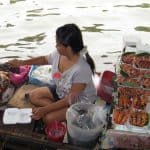Using the Emerging Markets Index released by Mastercard back in October, I’ve created something I’m going to call the Emerging Destination Index as a tool to provide clues as to which non-traditional tourist destinations may provide the fundamental infrastructure to sustain the type of travellers that I’ve been discussing over the last little while in this blog.
The original index data is available from Mastercard, and all I did was to reconfigure the weights assigned by the original methodology to assign more value to those dimensions that have a higher impact on the ability of a traveller to operate remotely from the region with fair access to a urban standard of living. These are the weights I assigned:
- Economic and Commercial Environment (0%) – Used in the original index to measure time and costs for building a standard warehouse, registering a property, exporting/importing cargo, and rate corruption and foreign bond, it seemed mostly irrelevant for the purpose of this index, so I left it out.
- Economic Growth and Development (10%) – Measuring the broad economic health and growth of the national economy this dimension seems to be the best way of describing the level of infrastructure that will ultimately support most activities from those visiting. It will also likely be related to the level scope of urban areas and the availability of important infrastructure outside of the major cities.
- Business Environment (7%) – Reflects the ability to setup a business. After all in order for travellers to gain access to the region, business must prosper along with all their suppliers, just so the visitors can enjoy their stay with a guarantee of fundamental services.
- Financial Services Environment (6%) – The availability of financial services to sustain the traveller during the stay.
- Commercial Connectivity (16%) – While I made the point that no place on Earth is remote anymore, this dimension measures city connectivity to other world and regional commercial centers by air, airline passenger volumes, presence of foreign consulates/embassies, international hotels, convention/meeting facilities, and international trade.
- Education, and IT Connectivity Environment (12%) – The availability of basic IT infrastructure may be key for those trying to maintain their links to work life active while on the region.
- Quality of Urban Life (28%) – Measures the quality of life by considering: personal freedom/media and censorship, medical and health considerations, public services and transport, recreation and culture, mortality, and the presence of world heritage sites. For someone looking to make a trip to a region for a few weeks, this dimension alone provides the most important aspect of the index on whether the visit will be full of memorable experiences.
- Risk & Security (21%) – Gauges a city’s overall risk and security through personal freedom, personal physical safety and the political and social environment. A concern in most emerging regions continues to be personal security and while a destination may be inviting, venturing outside of the usual tourist destinations will require the region to provide a basic safety guarantee.
Here are the top 10 destinations according to this index:
- Shanghai
- Budapest
- Warsaw
- Beijing
- Buenos Aires
- Kuala Lumpur
- Sao Paulo
- Santiago
- Mexico City
- Bangkok
I’ll be happy to share the full list of 65 with anyone that is interested.








So I came across this post via Twitter search. I really like how you’ve tweeked the index to measure something more meaningful. Plus I feel a little smug as I live in Budapest and think it’s great, certainly well deserving of its high position. Go Budapest!
I like your index calculations and has been very interesting for me to read your blog. I think you dropped and revalued dimensions in a correct way. It is the Emerging Destination Index title that has been bothering me for a couple of days as you call these non-traditional destinations. These leads me to believe you should have added another dimension to your index that most likely would have taken Beijing and Mexico City away from this list. As a Mexico City resident and a tourism specialst, I can’t call Mexico City an “emerging destination” as it hosts more tourists than Rome does yearly, of course it hosts less than Madrid and others. Olympic capitals? IMHO Beijing and Mexico City without any statistic do not deserve the emerging title at all. Not only because of the Olympics but because they’re each home to one of the world’s only three distinctive original cuisines along with the French. Number of Ancient sites, number of museums, number of UNESCO World Heritage Sites will at least certainly take Mexico City off the list. International O&D air traffic and conectivity takes Mexico City beyond any comparison as it is not only done through Monterrey, Cancun and Tijuana, but through LAX, DFW, Houston, Chicago, Miami, San Francisco, Vancouver, New York, etc… like no other. Hotel capacity: The week before the Beijing Olympics, Mexico City hosted The AIDS 2008 World Conference where we had twice as many participants as Beijing had athletes. I’d think that if you add some of these other HEAVY touristic dimensions, Mexico City, despite any reputation it has in different parts of the world for its good or bad, will most likely be left out by far of anyhing called an “emerging destinations list”.
Carlos, very strong argument. The original index issued by Mastercard was called the Emerging Markets Index of which Mexico is without a doubt a main actor. It was too easy to play with the words to name the new index I created, but you’re right in that many of these are not Emerging Destinations. You just gave me an idea on how to tweak this index by adding another dimension that evaluates the number of tourists per capita (or something like that) and use that value inversely to push “less frequent” destinations to the top and more popular ones to the bottom.
Pingback: on being emerging | Global Culture